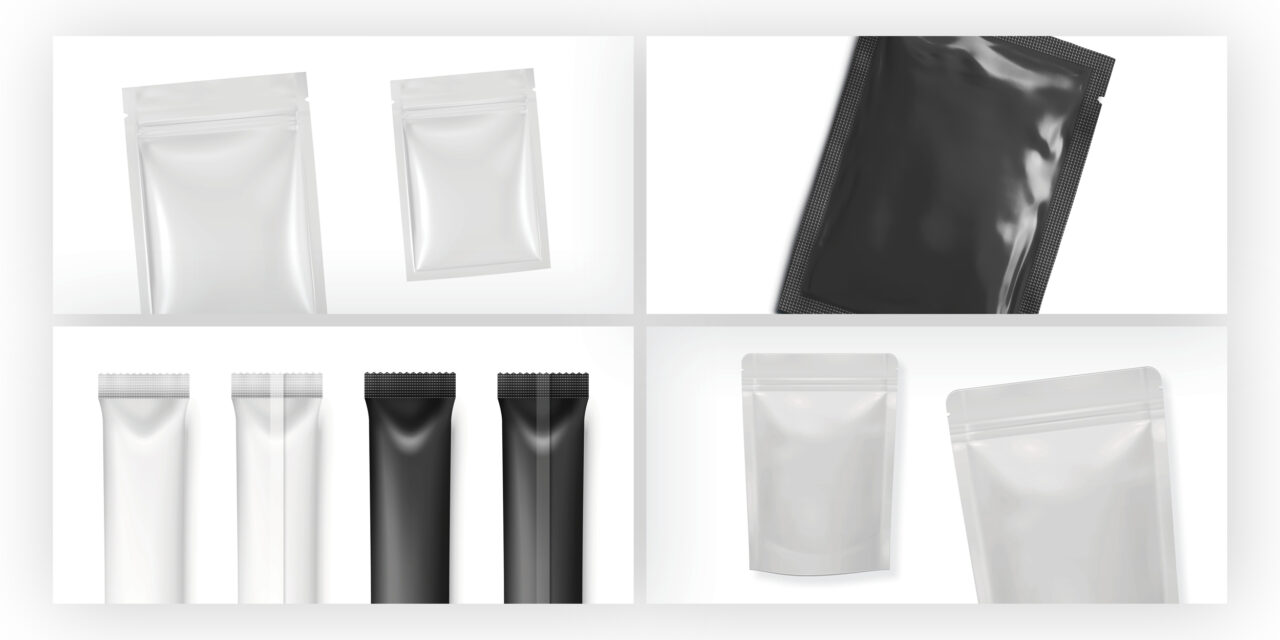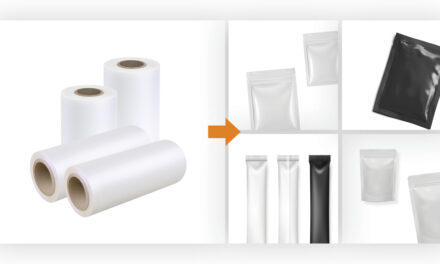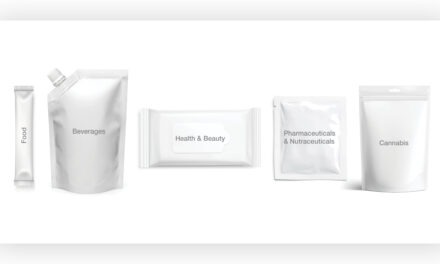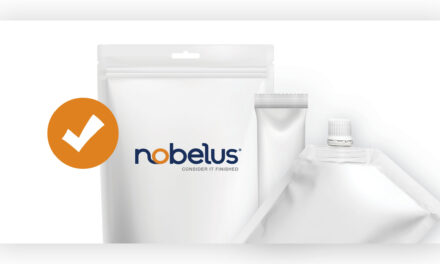WHAT IS FLEXIBLE PACKAGING?
Often shortened to flexpack, flexible packaging includes any type of package made from a flexible web as opposed to rigid materials, such as cardboard, glass, or molded plastics. A familiar illustration of this contrast would be the difference between a paperboard box of crackers (rigid packaging) and six crackers sold in a clear plastic wrapper (flexible packaging). Rigid packaging is designed to prevent products from being crushed or deformed by giving them a sort of protective shell, whereas flexible packaging is the preferred method for protecting products from moisture, mold, and spoilage through other environmental factors. In certain applications, rigid packaging and flexpack can be seen working in tandem to provide complete protection, such as air-tight bags of cereal stored in colorful boxes.
While flexible packaging is certainly not a new concept – chip bags, candy wrappers, and juice pouches have been staples in the grocery store for decades – the industry has recently begun taking over more and more of the packaging space. The boxes, cartons, bottles, and tubs that have traditionally populated store shelves are now being forced to compete with an entirely different breed of packaging as more brands integrate flexible designs in previously unexpected ways. Consider how aisles that once consisted entirely of rigid packaging are now dotted with flexpack alternatives – pouches of laundry detergent pods and bags of organic oats where bulky tubs and canisters once spanned the aisles unchallenged.
WHY ARE BRANDS CHOOSING FLEXIBLE PACKAGING?
While market data shows that most brands still prefer traditional rigid packaging for a variety of reasons – and many utilize a mix of the two mediums – flexible packaging offers certain benefits that make it a superior option for many applications and product types.
Cost
Unlike rigid packaging, which must be a certain thickness to maintain its structure and stability, flexible packaging is designed to be as thin as possible while still meeting the brand’s performance requirements. This massively reduces materials costs compared to thicker structures and enables more product to be packed into a defined space in shipping, warehousing, and on crowded store shelves. In a similar vein, flexpack is typically more lightweight than rigid materials, reducing freight and handling expenses.
In terms of efficiency, flexible structures can be produced in massive volumes very quickly. Conventional flexpack converters are typically able to supply brands with millions of impressions, or units, in a matter of weeks, and converters with a digital press can take mere days to ship an order from the time it is placed. Speed to market and streamlined production enable brands that use flexible packaging to reliably meet customer demand so they never miss out on a sale. When it comes to cost per MSI, it is simply difficult for rigid packaging to compete with flexpack.
Performance
Although flexible packaging may seem simple and flimsy at a glance, it is typically composed of several carefully selected layers that each serve a unique function, which can include anything from increasing the package’s mechanical durability to preventing sunlight from reaching the product. Converters, the manufacturers who combine these thin layers with other materials or otherwise alter them in some way, carefully create structures with a specific set of properties designed to match the product that will be packaged.
The materials used in these structures can range from paper and plastic to extremely thin foils and metalized films and that keep oxygen from entering or leaving the package. Barrier layers are carefully selected for each application to prevent or reduce the transmission of gases, moisture, light, and caustic chemicals. The flexible packaging industry uses a range of sealing methods to ensure packaging is easy to open even as the seal protects the product from damage. Even a humble beef jerky wrapper is a highly specialized feat of engineering designed to maximize the shelf life of the product and keep consumers safe when they unwrap their snack.
Marketing Opportunity
Flexible packaging is an excellent choice for brands that want their marketing to be consistent across a variety of applications. A brand that offers several types of products that each require specialized packaging can find a flexpack converter who will take their designs and apply them to stand-up pouches, sachets, wrappers, and more all within the same operation, streamlining pre-press and ensuring each element is closely aligned across every medium. For this reason, flexible packaging is becoming more common in subscription-style service models where a brand wants to maintain design consistency across several different types of products, such as meal prep kits, pet supply subscriptions, and monthly cosmetic boxes.
Because the various permutations of films, inks, adhesives, and other manufacturing elements that can be utilized in flexible packaging are nearly endless, converters can offer a huge range of value-add features and embellishments compared to rigid packaging and prime labels. Uniquely shaped packaging, compatibility with a variety of finishing methods, and variable-data content that supports hyper-local marketing and interactive QR codes can all be used as ways to make flexible packaging stand out from the competition on the shelf.
Accessibility
With the advent of digital presses, smaller brands are now able to source high-quality flexible packaging at whatever volumes they need, opening the door to more variety on store shelves as artisanal and specialty products become more accessible to the average consumer. On the other hand, for everyday essentials with a short shelf life, such as bagged bread or raw meats, flexographic presses can produce packaging at extremely high volumes so that these products can be rotated regularly. Regardless of what a brand sells, a flexible packaging operation exists that can meet their unique needs and offer consumers easy access to a range of products.
From a usability perspective, flexpack can be engineered to accommodate consumers who have dexterity issues or otherwise struggle with certain types of packaging. Converters can add tear notches or use easy tear films to ensure products like drink powders and common home items require little strength or manipulation to use. On the other end of the spectrum, restricted-access products, like cannabis or medication, can be designed to reduce the risk of children getting into things they shouldn’t. Fitments such as zippers, spouts, and re-sealable tabs all enhance the consumer experience and enable people of all ages and ability levels to enjoy a range of products.
Sustainability
As mentioned before, flexible packaging is typically very lightweight and can be packed tightly on a pallet. This practice greatly reduces emissions in freight and shipping by requiring fewer trips and maximizing how much product a single truck, train, or ship can carry. While most types of flexible packaging are not recyclable or compostable, their thin designs take up far less space in landfills, increasing how much refuse can fit in a single plot and minimizing the impact a landfill has on the surrounding environment. As sustainability becomes a greater focus due to consumer demand and new government regulations, flexpack converters are seeking out ways to reduce the impact their products have on the planet, such as choosing thinner materials, also called downgauging, using mono-materials, and utilizing plastic-free and compostable films that are less likely to end up in a landfill.
FLEXIBLE PACKAGING IN ACTION
One of the greatest strengths of flexible packaging is just how many different shapes and functions it can adopt to suite a wide variety of markets and applications. If you pay attention next time you walk through a grocery store, you’ll see some examples of flexible packaging on nearly every aisle, from the snack foods section and freezer merchandisers to the deli coolers and health and beauty shelves.
As more people seek out snacks they can take on the go to accommodate their busy schedules, individually portioned treats are becoming progressively more popular. Granola bars, fruit bars, and dehydrated goods are all perfect applications for flexible packaging since they require little structural reinforcement and can be easily tossed into a backpack for outings. Tiny portions are popular outside of the snack food space, as well. Sample-sized lotions, stick packs for supplements, and pre-portioned medications or nutraceuticals are other small-scale applications that utilize flexpack to enhance the customer experience.
Bulk applications can also benefit from flexible packaging in the form of lightweight pouches and fractional packaging. Stand-up pouches represent a huge percentage of the flexpack market and can be designed with a variety of fitments that support larger product volumes, such as valves that keep bulk tea and coffee fresh or zippers that can be reclosed to keep product from going stale. Fractional packaging includes any type of package where individual units, such as chocolates or cough drops, are contained within a larger bag to keep product from sticking together.
The Modern Flexible Packaging Industry
According to the Flexible Packaging Association (FPA), the U.S. flexible packaging industry generated $29.5 billion in sales in 2021 (excluding items such as trash bags, retail shopping bags, and storage bags). Flexpack represents an impressive 20% of the U.S. packaging industry and is second only to corrugated paper in terms of market share. Food applications account for 52% of the flexpack market, with medical/pharmaceutical and consumer products representing 9% and 8% of the market respectively. Current growth estimates project a steady increase in market value ranging from 4.2% to 4.5% over the next several years, with anticipation of continued long-term growth as more brands and consumers turn to flexible packaging as their preferred packaging type.
While a handful of companies show overwhelming dominance in the market, the breadth of applications and market segments that the flexible packaging industry serves enables single-facility operations and large corporations alike to carve out their niche and maintain healthy margins. New digital converters regularly penetrate the market by being creative and intentional with the equipment and processes they invest in, carefully selecting niches where their operation can offer superior speed to market or pivot quickly for high-margin products.
Whereas larger conventional flexpack operations have traditionally focused on the performance of the structures they create and considered designs to be a secondary concern, modern brands are starting to pay more to increase the aesthetic appeal of their packaging. This industry shift provides an excellent opportunity for printers from industries that prioritize design elements, such as prime label converters, to invest in flexpack and offer brands superior graphics and value-add effects. As the flexible packaging industry grows, it also continuously changes to meet the demands of new markets that defy conventional wisdom, such as cannabis, which has products that could be classified as food, medication, beverages, and more.
FLEXIBLE PACKAGING AND LAMINATION
While print layers should not be relied upon to provide a flexible package with any performance-enhancing characteristics, they do serve a vital aesthetic purpose in marketing products to consumers. Without bright colors, eye-catching imagery, and value-add effects, even the most well-made package can be overlooked on a store shelf. As the average number of SKUs in grocery stores and other retail locations climbs ever higher, it is more important than ever before for brands to make sure their packaging stands out through creative designs and high-quality finishes.
Much like an overprint varnish or lacquer, a laminate or film can serve as a durable outermost layer that buries ink to protect it from a variety of factors, including humidity, grease, and dirt. On top of this, certain laminates even have an extra durable finish that prevents scuffing or smudging in transit and throughout the daily life of the end consumer. Thermal laminates include a thermally activated adhesive layer that cures immediately after application, enabling the package to be processed further the same day. On the other hand, unsupported films lack an adhesive layer and must be combined with a wet adhesive before they are either left to dry for a minimum of one to two days or rapidly cured through a UV, LED, or electron beam energy system.
Regardless of which type of film is used, converters can offer brands a wide range of finishes that add value to flexible packaging. Nobelus unsupported films are available in standard gloss and matte finishes for cost-effective print protection, but specialty finishes, such as the luxurious soft-touch Karess® Film and the stunning Rainbow Holografik™ Film, are also available to give packaging an edge over the competition. For eco-conscious brands, our sustainably sourced EcoElement™ CLS Films provide a completely plastic-free option for compostable packaging with both a gloss and matte finish available. Nobelus thermal laminates come in an even broader range of finishes with various thicknesses to accommodate a host of applications.
WANT TO LEARN MORE?
Whether you’re a new converter who wants to learn more about the flexible packaging industry or a brand representative who isn’t sure whether rigid or flexible packaging is better for you, feel free to reach out. Our industry experts are always eager to provide guidance and education to help our customers make decisions that fit their unique operational needs. We also welcome questions about what finishing solutions we offer and can help you decide if one of our films will fit your specific application. You can get connected through phone or email or by following the link below.





